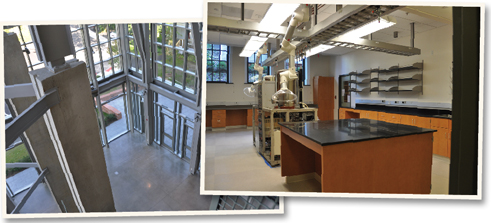A Busy Season for Ford Hall Tours
By Jan McCoy Ebbets

Recently completed and newly dedicated, the gleaming Ford Hall is Smith's new home to engineering and the sciences. Its tall windows make use of natural light, and its advanced building design provides more space for teaching and laboratory projects and promotes collaboration among related disciplines. Classes will be taught here beginning in the spring. Photos by Judith Roberge.
It was a Friday morning about six weeks before the completion of construction, and Stylianos Scordilis, professor of biological sciences and tour guide, was patiently waiting for a group of Smith staff members to assemble—and don their hard hats—on a campus pathway on Green Street. Then he would lead them on a tour of the sleek new Ford Hall, where finishing touches were being applied to the largest and most sophisticated facility ever built at Smith on behalf of advancing women in the sciences and engineering.
The new state-of-the-art science and engineering building houses some 142,000 square feet of classrooms, teaching and research labs, meeting rooms and faculty offices for the departments of computer science, chemistry, biochemistry, molecular biology and the Picker Engineering Program. It is named in honor of the lead donor to the project, the Ford Motor Company Fund.
In recent months, Scordilis, who is also director of Smith's Center for Proteomics, has led more than 40 tours in his other role as official special assistant to the president for Ford Hall. While his teaching and research—on the study of the molecular physiology of skeletal muscle—are the first priority, he is also amenable to shoehorning into his schedule time to accommodate tour requests from those anxious to see Ford Hall as it emerges from the construction zone. He seems to know every inch of the pioneering $73 million structure, of which he is immensely proud.
"Every aspect of the technologically complex Ford Hall is impressive," says Scordilis, who has taught at Smith for 31 years. "Serious science types are going to find this building quite engaging."
During the Ford Hall tour, he cites intriguing numbers and facts. For example, the 142,600-square-foot structure ("that's a lot of building!") features 80 miles of electrical wire, 40 species of plants indoors and 20,000 square feet of planted "green roof" as well as two 30,000-gallon rooftop tanks to collect rainwater to be used as gray water. Two centers will occupy Ford Hall: molecular biology and proteomics.
"This is one of my favorite rooms," Scordilis says, leading the visitors to the third-floor meeting room—one of three stacked on the north wing. It is an airy, light-filled space with a wall of windows overlooking the campus. "If I'm going to be sitting here," he laughs, "I'm going to have to sit facing away from the windows. Otherwise there's going to be too much distraction out there—it's too pretty."
He notes that all of Ford Hall's spaces will be lit by a special computer-operated system that senses the light level in each room and adjusts the level of fluorescence to maintain a constant degree of light, one of the many features that contributes to the building's expected Leadership in Energy and Environmental Design (LEED) certification.
Ford Hall will be Smith's first LEED-certified green building; it was designed by the architecture firm Bohlin Cywinski Jackson, with sustainability as one of its guiding principles. The building incorporates such design elements as a green roof; porous pavement; shading for temperature control; and highly efficient heating, lighting, ventilation and water use systems.
While Scordilis shows visitors through the three levels of classrooms, the three-story atrium, communal research spaces, case study rooms and teaching labs (as the state-of -the-art lab equipment is being installed), he points out that the facility's design promotes a collegial atmosphere that fosters educating students in specific disciplines while encouraging them to explore connections across disciplines. Spaces are designed to allow faculty and students from different departments to work together in teams, to move easily from the laboratory to a group study session to the classroom, reflecting the collaborative nature of today's research and teaching.
"The building has a lot of room for interdisciplinary interaction among all the folks who are going to be in Ford Hall," he says.
On the second level is Scordilis' lab in room 202 and adjacent office in 202B. He tells the group that all classrooms will be moved and set up in December. Classes will be taught here beginning with the spring semester 2010. Ironically, Scordilis says, that is the semester he goes on a semester-long sabbatical.
Two years after the groundbreaking, Ford Hall was officially dedicated on October 16. The ceremony was preceded by a 4 p.m. panel discussion—Building the Future: Smith College's Leadership in Science and Engineering—featuring alumnae representing each of the five sciences and moderated by Scordilis.
|























